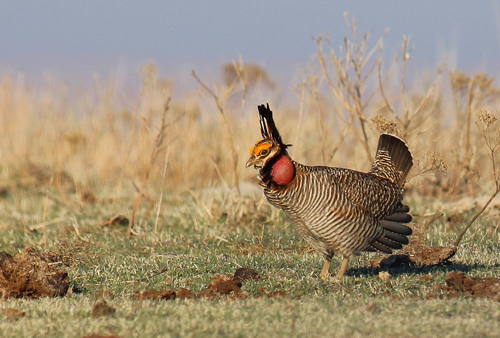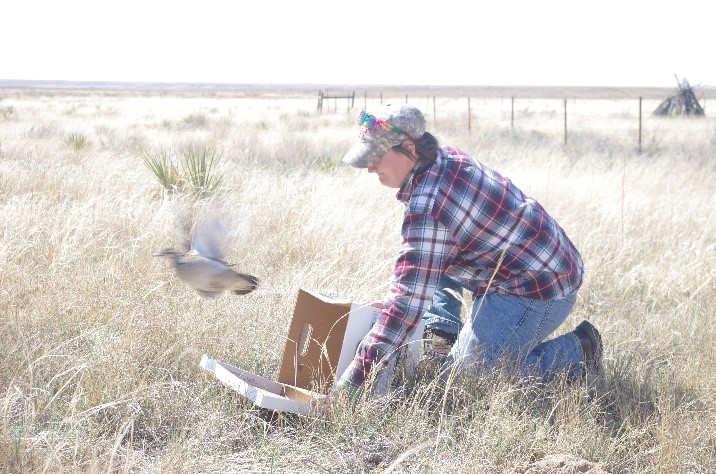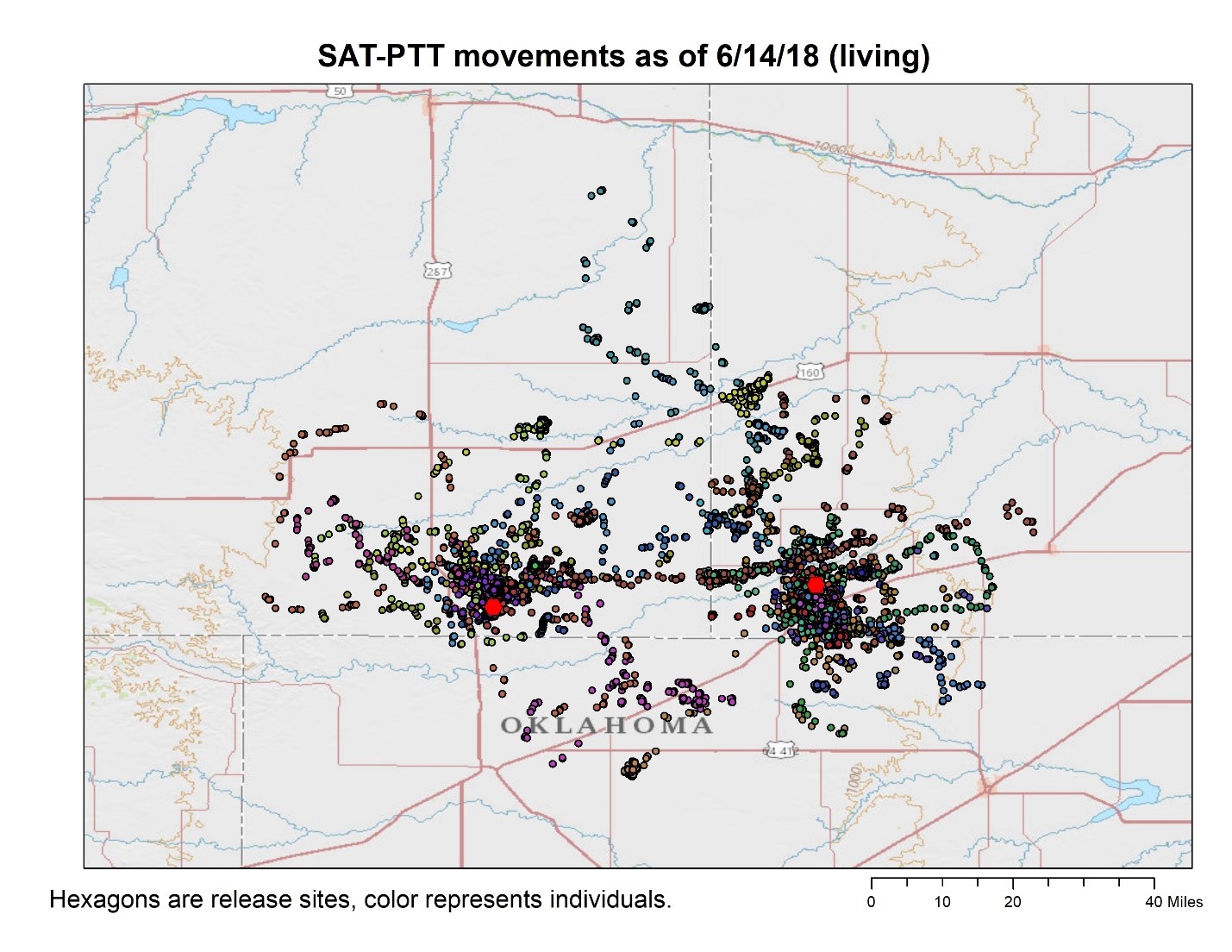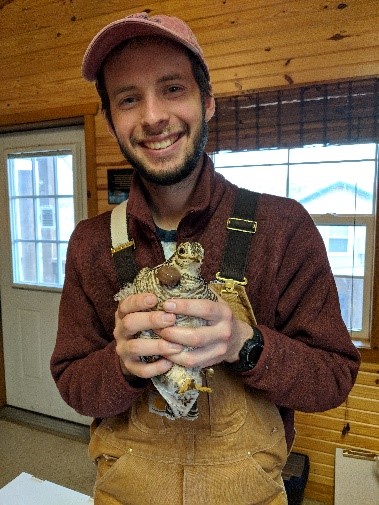Assessment of Lesser Prairie-Chicken Response to Translocation
Investigators:
Liam Berigan, M.S. student
Carly Aulicky, Ph.D. student
Elisabeth Teige, M.S. student
Project Supervisor:
Dr. David Haukos
Funding:
Kansas Department of Wildlife, Parks and Tourism
Colorado Parks and Wildlife
Cooperators:
Kansas State University
Kansas Department of Wildlife, Parks and Tourism
Colorado Parks and Wildlife
Location:
Capture site in northwestern Kansas, release sites in southwestern Kansas and southeastern Colorado
Completion:
May 2020
Status: Completed
Objectives:
Restore long-term persistence and distribution of LEPC within the Sand Sagebrush Ecoregion
Assess the feasibility of translocations as a management tool for restoring LEPC populations
Progress and Results:
The U.S. Forest Service Cimarron and Comanche National Grasslands in southwestern Kansas and southeastern Colorado was a stronghold of the lesser prairie-chicken’s historic range. However, grazing practices on the grasslands, coupled with several years of intense winters and severe drought, led to their near extirpation by 2013. Since then, implementation of beneficial land management practices and amelioration of drought conditions have allowed the vegetation to recover. The area consists of high-quality habitat, although there are few leks within dispersal distance of the grasslands. Without a nearby population source, restoring lesser prairie-chickens to the Cimarron and Comanche National Grasslands will require human intervention.
In 2016, a multi-agency effort began to restore lesser prairie-chicken populations in the Sand Sagebrush Ecoregion by translocating birds to the National Grasslands. Beginning that fall, state biologists began to translocate lesser prairie-chickens from northwestern Kansas to several release sites on the Cimarron and Comanche. A total of 26 males were released in the fall of 2016 to establish and supplement leks prior to relocation of females onto the grasslands. In the spring of 2017, 45 additional males and 38 females were released onto the grasslands. All birds released in 2016 and 2017 were equipped with VHF radio transmitters to track their dispersal, survival, and fecundity.
Dispersal from release sites was variable, and often extensive (mean = 18 km, sd = 16 km). However, 75% of released birds stayed within the vicinity of the Comanche and Cimarron National Grasslands. Fall and spring released males attended 10 leks in spring 2017. Within those 10 leks, males utilized 5 novel areas to display, however, due to the ephemeral status of these areas, it is unclear if these new leks will persist into subsequent breeding seasons. Attendance at lekking sites has fluctuated widely, and will continue to be supplemented with annual releases of males.
For birds released in spring 2017, apparent survival to the next fall was 40%, reflecting the increased mortality rate which often accompanies translocation projects. Nearly all surviving females attempted to nest in 2017. Of the 16 attempted nests, 7 hens raised at least one chick past 35 days. Several hens which attempted to nest in 2017 have also returned to nest near the grasslands in 2018.

In Spring 2018, 71 males and 73 females were translocated to the grasslands. This year incorporated our first use of satellite-PTT transmitters on the project, with 65 SAT-PTT and 64 VHF transmitters deployed on released birds. Preliminary data from satellite transmitters has shown that initial dispersal movements from the release site can exceed 100 km. Despite long distance dispersal, translocated birds frequently circle back towards the initial release site. The improved resolution of SAT-PTT transmitters will allow us to determine how landscape features influence each prairie-chicken’s home range establishment on an individual scale, and may provide valuable insights for liming dispersal during future translocation projects.

Products:
Professional Presentations:
Aulicky, C., and D. Haukos. 2018. Testing the hotspot hypothesis: lesser prairie-chickens lek formation and female space use. International Grouse Symposium, Logan, Utah.
Aulicky, C., and D. Haukos. 2018. What can we learn from morphology? A study of the lesser prairie-chicken (Tympanuchus pallidicinctus) in Kansas. Kansas Natural Resources Conference, Manhattan, Kansas.
Aulicky, C., D. Haukos, and K. Fricke. 2018. Not just dusty data: what can we learn from range-wide analyses of lesser prairie-chicken morphology? Annual Meeting of The Wildlife Society, Cleveland, Ohio.
Berigan, L., D. Haukos, D. Sullins, and K. Fricke. 2018. Lesser prairie-chicken translocation: minimizing dispersal to ensure translocation success. Kansas Natural Resources Conference, Manhattan, Kansas.
Berigan, L., D. Sullins, D. Haukos, K. Fricke, J. Reitz, L. Rossi, and K. Schultz. 2018. Translocation of lesser prairie-chickens: does lek presence limit dispersal? Annual Meeting of The Wildlife Society, Cleveland, Ohio.
Berigan, L., D. Sullins, D. Haukos, K. Fricke, J. Reitz, L. Rossi, and K. Schultz. 2018. Role of natal habitat preference induction in prairie-grouse translocation success. International Grouse Symposium, Logan, Utah.
